Abstract
We experimentally demonstrate a stable and compact high pulse energy mid-infrared (MIR) 6.45 μm laser, which is produced by an optical parametric oscillator (OPO) based on the non-oxide BaGa4Se7 (BGSe) nonlinear crystal pumped by 1064 nm Nd:YAG laser oscillator. With optimizing the parameters of the OPO system, a record high idler energy of 6.76 mJ at 6.45 μm was obtained with 18.85 ns of pulse duration (FWHM) at the repetition rate of 10 Hz under 93.5 mJ of pump energy, corresponding to an optical-to-optical conversion efficiency up to 7.23% from 1064 nm to 6.45 μm. The experimental results were in close approximation with the theoretical calculations. To date, it is both the highest MIR pulse energy and the highest conversion efficiency at 6.45 μm for any 1 μm pumped OPOs. Further, excellent output energy stability is demonstrated, with an energy fluctuation of less than ±0.5% over 165 min. Such a laser is interesting for both scientific and medical applications, including, for instance, for trace gas analysis and tissue ablation.
1. Introduction
Recently, mid-infrared (MIR) coherent sources have always been intensively sought for their wide applications in fundamental strong scientific and technological fields, such as medicine, gas detection and high-resolution chemical spectroscopy analysis [1,2,3]. Furthermore, many research studies show particular interest in the lasers emitting at the wavelength of around 6 μm. For example, a pulsed laser source operating in this spectral region at 6.45 μm is of key importance for tissue ablation in humans due to the coinstantaneous absorption by both proteins and water. It has been demonstrated that the MIR 6.45 μm laser scalpel, in particular, has potential application in high-precision medicine, with the advantages of a high ablation rate and minimal collateral damage in biological tissue [4,5]. So, the exploration of a high-performance 6.45 μm MIR laser source is urgently thirsty.
Compared with traditional free electron lasers [6], Raman lasers [7] and strontium vapor lasers [8], all solid-state lasers are superior to those in applications. In solid-state lasers, by frequency down conversion, the optical parametric oscillator (OPO), composed of a NLO crystal, a pump source and a resonant cavity, is widely regarded as a compelling and feasible solid-state source of coherent radiation access to high pulse energy and high average power MIR spectral region. Especially for low peak pump power, OPOs with a resonant cavity can achieve high gain to reach the threshold by round trips of the resonated waves. Therefore, it can be said that OPO based on the different NLO crystal materials supplies a simple, stable and efficient method to obtain such high pulse energy and high average power lasers [9].
As the central module of the OPOs, the characteristics of NLO crystals are determining factors in the performance of nonlinear frequency conversion. ZnGeP2 (ZGP) crystal is a crucial NLO crystal for MIR radiation. ZGP-OPO is an ideal way to obtain high-efficiency laser radiation at around 6 μm in view of its excellent physical and chemical properties, high thermal conductivity, high nonlinear coefficient and high damage threshold [10]. However, ZGP crystal exhibits a severe absorption effect at a near-infrared wavelength of around 1 μm and thus has to be pumped by laser radiation above a 2 μm wavelength, whose pump sources with high performance are expensive and complicated. To date, with the rapid development of a variety of promising NLO crystals, such as AgGaSe2 (AGSe) [11], BaGa4Se7 (BGSe) [12] and CdSiP2 (CSP) [13] crystals, a very straight possibility would be a mature 1 μm pumped OPOs to create wavelengths above 6 μm. Similarly, among these crystals, each has its own advantages and disadvantages. For example, AGSe crystal possesses wide transparent regions but has a low laser damage threshold, which restricts its capability to achieve a high pulse energy and high average power long wave MIR laser. Additionally, CSP crystal shows an excellent nonlinear effect and exhibits exceptionally high nonlinearity. For instance, with CSP-OPO synchronously pumped by a master oscillator power amplifier (MOPA) system at 1064.1 nm with 8.6 ps, an idler pulse energy up to 1.5 mJ has been achieved at 6.275 μm with an optical-to-optical (o-o) conversion efficiency of 5% [14]. The idler wavelength is tunable over 486 nm. Unfortunately, when pumped by a 1064 nm laser, for type I phase-matching this exhibits idler wavelengths that are approximate to the upper-wave transparency limit which is essential to minimally invasive surgery in the spectrum wavelength near 6.45 μm and reachable by working at 122 °C [15], which is inconvenient to use. On the other hand, BGSe crystal is a commonly available MIR NLO crystal due to large nonlinear coefficients (d16 = 31.5 and d23 = 22.1 pm/V) [16], wide transmission range (0.47–18 µm), wide bandgap (2.64 eV), moderate birefringence (Δn = 0.08 @ 1 μm) and high laser damage threshold (557 MW/cm2) [17]. BGSe crystal is a part of the monoclinic class, point group m, space group Pc and is a positive biaxial crystal. This NLO crystal has good growth performance, and it is easy to obtain large-size and high-quality crystals, which are fit for the achievement of high average power and high pulse energy MIR waves. Recently, a tunable MIR (2.7–17 μm) BGSe-OPO pumped by a 1064 nm laser was presented. With a high pump energy of 27 mJ from a Nd:YAG MOPA system, an output pulse energy of ~1 mJ at 6.45 μm with a pulse duration of ~10 ns and a pulse repetition rate (PRR) of 10 Hz was obtained, having an o-o conversion efficiency of 4% [18]. However, the MOPA laser system was quite complicated, bulky and costly. With a model that was still very new, based on a BGSe-OPO pumped by a more simple and compact 1064 nm laser oscillator, we successfully scaled pulse energy at 6.45 μm to 1.23 mJ under 58 mJ pump energy, with a pulse duration of 24.3 ns and a PRR of 10 Hz, corresponding to an o-o conversion efficiency of 2.1% [19], where an unfocused pump spot with a diameter of 2 mm and a BGSe crystal with the length of 18 mm were employed. In addition, for OPO laser system, as shown in [20], the output pulse energy and o-o conversion efficiency decrease with the increase in PRR due to the severe thermal effect. Further, the available 1064 nm light source with high pulse energy in our laboratory works at 10 Hz. Therefore, in our work, high pulse energy 6.45 μm MIR laser with the PRR of 10 Hz is researched.
Here, by improving the NLO BGSe crystal growth technique and optimizing crystal length and the transmittance of the output coupler (OC), we have demonstrated a stable and compact high pulse energy, high-efficiency MIR laser from BGSe-OPO system pumped directly by 1064 nm Nd:YAG oscillator. Compared to our previous work, we increased the NLO crystal length from 18 to 25 mm in order to achieve a higher MIR pulse energy and the pump beam diameter from 2 to 6 mm to prevent the risk of damage in the optical components for higher pump levels. Thus, unprecedented pulse energy of 6.76 mJ at 6.45 μm was obtained with a pulse width of ~18 ns by a double pump passing singly resonant OPO (DP-SRO) configuration, corresponding to o-o conversion efficiency up to 7.23%. So far as is known to the authors, this is both the highest pulse energy and the highest o-o conversion efficiency that have been reported so far for MIR OPOs at 6.45 μm laser pumped directly by a 1 μm laser. The fluctuation of the output energy and the average beam quality factors M2 were evaluated to be less than ±0.5% over 165 min and to be 9.515, respectively, at idler output pulse energy of ~4.5 mJ. This work illustrates that the BGSe-OPO pumped by 1 μm is an effective way to achieve a high pulse energy, high-efficiency and high-performance MIR laser radiation.
2. Experimental Setup
The schematic of the experimental configuration for BGSe-OPO is depicted in Figure 1a. Firstly, the high-energy pump laser system is produced by an electro-optically (EO) Q-switched Nd:YAG oscillator at 1064 nm. The pump laser system can provide the highest output energy of ~110 mJ at the PRR of 10 Hz at ~10 ns (full width at half maximum—FWHM) pulse duration. It has an approximately Gaussian temporal and spatial profile. Due to the OPO system being configured with a double pump passing cavity, an optical isolator (ISO) behind the pump source was utilized to prevent possible damage to the Nd:YAG oscillator from the reflected pump light. Meanwhile, a combination of a half-wave plate (HWP) and a 45° polarized beam splitter (PBS) was used to alter input pump energy with vertical polarization into the OPO without changing the pulse width and pump beam spatial profile. Dumper was a black body to absorb the leaked pump energy.
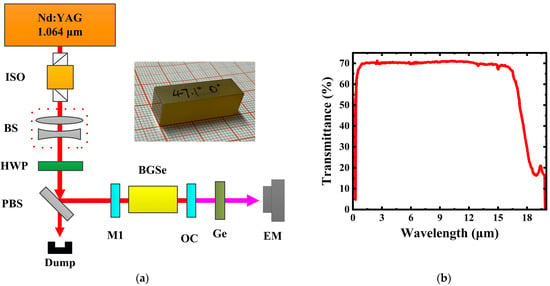
Figure 1.
(a) Schematic diagram of the BGSe-OPO pumped by 1064 nm Nd:YAG oscillator laser. Inset: photograph of the adopted BGSe crystal. ISO: optical isolator; BS: beam shaper; HWP: half-wave plate; PBS: 45° polarized beam splitter; M1: input plane coupler; OC: output plane coupler; Ge: germanium filter; EM: energy meter. (b) The transmittance curve of the uncoated BGSe sample with a thickness of 15 mm.
In order to avoid damage to the optical modules at the high pulse energy level and allow stable operation for a long time, the pump beam was not focused and a beam shaper (BS) system was employed to reshape and collimate the pump beam to a large spot diameter of about 6 mm (D4σ) in the position of the OPO. The corresponding highest peak on-axis intensity of ~35 MW/cm2, which was much less than the damage threshold of antireflection (AR) coating at BGSe crystal end facts (~80 MW/cm2). The design of a large pump beam can curb the influence on the output results from spatial birefringent walk-off between the beams. Consequently, a BGSe crystal with a large cross-section of 8 × 8 mm2 was chosen, cut at θ = 47.1° and φ = 0° with respect to the x–z principal plane for type I phase matching (e → o + o) condition based on the Sellmeier equations (S-E) in [21] to ensure large effective nonlinearity. Furthermore, the effective nonlinear coefficient can be counted with deff = d16cos2(θ) + d23sin2(θ) in this condition, derived from the symmetry of BaGa4Se7 crystal. Both crystal facets were finely polished and had AR coatings for the pump, signal and idler waves. The reflection loss at each surface was no more than 1% at 1064 nm.
In order to obtain large-size, high-quality crystals with few defects, two aspects are improved in the NLO crystal growth process by the Bridgman–Stockbarger method. First, the BGSe crystal was synthesized by high pressure, which can provide more homogeneous polycrystalline raw material with fewer impurities. Second, the crystal growth temperature field was optimized with the use of COMSOL Multiphysics simulation software to help reduce the internal defects of crystals and obtain large-size samples [22]. In addition, the transmission curve of the uncoated BGSe sample with a thickness of 15 mm, in the range of 0.2~20 μm, is shown in Figure 1b. It presents higher transmission in the range of between 1 μm and 12 μm and can extend up to 18 μm.
The BGSe-OPO was set up in a linear cavity architecture. Plane mirror M1 with high transmission (HT) at the pump (T > 94% at 1064 nm) and high reflection (HR) for the signal and idler waves (R > 98% at 6450 nm and R > 96% at 1274 nm) was used as the input coupler (IC) of the OPO. The other plane mirror with an HR-coated pump and signal lasers (R > 98% at 1064 nm and 1274 nm) and AR-coated for the idler (T > 90% at 6450 nm) was used as an OC of the OPO. In this scheme, the resonance took place only for the signal beam. The DP-SRO design can effectively improve the oscillator stability, increase the idler MIR output, reduce the oscillation threshold and suppress the back conversion [23]. To lower the oscillation threshold and increase the output pulse energy, the cavity length was as small as possible to increase the number of signal wave roundtrips and reduce the diffraction losses in the OPO cavity. Therefore, the total OPO cavity including the BGSe crystal was about 30 mm in physical length. To ensure only MIR radiation at 6.45 μm was detected by an energy meter, a germanium (Ge) wafer with a transmittance of ~42% at 6.45 μm was set in the front of the energy meter to cut out signal and surplus pump beams. All measured OPO output results are corrected for these transmission losses. In brief, the large-sized pump beam with high peak power and a high gain DP-SRO configuration were employed to achieve high pulse energy and high conversion efficiency MIR laser at 6.45 μm.
3. Results and Discussion
In order to achieve a higher pulse energy MIR generation by DP-SRO configuration, the NLO crystal length needs to be carefully optimized to obtain a proper parametric gain. Suppressing the back conversion effect in NLO crystal, the pump energy can be transmitted to idler energy as much as possible. Firstly, a numerical simulation of the ns OPO process was performed to analyze the idler beam output characteristics, such as the output pulse energy, o-o conversion efficiency and temporal profile. In this simulation, we assume the pump beam with a Gaussian temporal and spatial profile and take into account the linear absorption, diffraction and beam spatial birefringent walk-off in BGSe crystal. For the collinear OPO process in ns regime, group velocity mismatch (GVM) can be ignored, so the mixing equations can be given by [24]:
where j indexes the frequency (signal, idler and pump). ρj are the walk-off angles in the x direction, the linear absorption coefficients in the BGSe crystal are αj and Aj are the spatial and temporal complex amplitudes of three waves. Pj are nonlinear interaction terms, which are shown by the following:
where
is the wave vector mismatch, ωj is the angle frequency of the three waves, deff is the effective nonlinear coefficient of the BGSe crystal for type I phase-matching at 6.45 μm pump by 1 μm. nj are the refractive indices of three waves in BGSe crystal and c is the speed of light in vacuum.
Considering the optical characteristics of the BGSe crystal, the OPO numerical simulation in the DP-SRO is carried out based on the above three-wave mixing theory in SNLO free program by the Fourier transform and Cash–Karp Runge–Kutta method [25]. The relationship between idler output characteristics at 6.45 μm and BGSe crystal length including output energy and o-o conversion efficiency is plotted under given input pulse energy of ~100 mJ for the pump beam diameter of 6 mm, as shown in Figure 2. It can be seen that the idler output energy (red solid line) and o-o conversion efficiency (blue solid line) both increase gradually up to the highest values of ~8.5 mJ and 8.5%, respectively, at the crystal length of ~25 mm. Subsequently, the saturation effects on both output pulse energy and o-o conversion efficiency appear for longer crystal owing to the back conversion effect. It can be found that choosing the suitable length of the NLO crystal can improve the o-o conversion efficiency and output pulse energy. Therefore, we employed an optimal 25 mm long BGSe with an aperture of 8 × 8 mm2 as OPO NLO crystal in the following experiment, which was grown by the improved Bridgman–Stockbarger method, as illustrated in the upper right inset of Figure 1a.
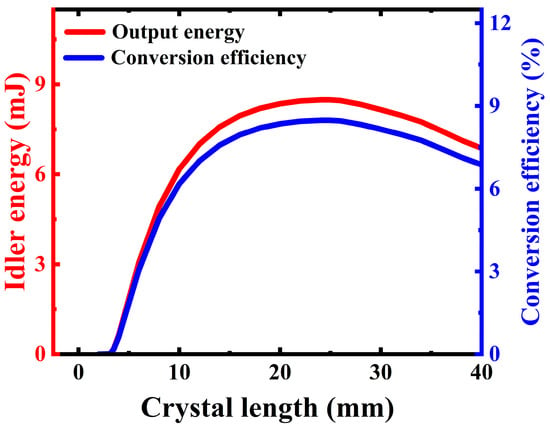
Figure 2.
Calculated BGSe-OPO idler output pulse energy and o-o conversion efficiency at 6.45 μm as a function of crystal length under given pump pulse energy of 100 mJ with a beam diameter of 6 mm.
Based on the above experiments, the input-output characteristics of the generated MIR waves at 6.45 μm were studied. The measured and simulated MIR idler energy and o-o conversion efficiency as the functions of the input pump energy is displayed in Figure 3. The black-filled circles and black solid diamonds describe the experimental data recorded by an energy meter (OPHIR, PE10). As depicted in the curves, the measured threshold pump energy of the 30 mm length BGSe-OPO cavity was about 10 mJ, which translated into the axial energy fluence of about 0.035 J/cm2. With the increase in pump energy, the output pulse energy and o-o conversion efficiency also increased monotonically. At the pump energy of ~79.9 mJ, the output pulse energy of the idler wave was 6.07 mJ, which corresponded to a maximum o-o conversion efficiency of ~7.6%. Then, as the pump energy rose, the o-o conversion efficiency began to drop while the MIR output pulse energy continued to grow. The idler pulse energy reached its maximum value of 6.76 mJ at a 10 Hz repetition rate with the continuously increasing pump energy to 93.5 mJ, which represented an o-o conversion efficiency of 7.24%, and then the output energy fell gradually for higher pump levels. That means the higher pump energy could not further enhance the output pulse energy. The rollover behavior could be dominantly attributed to the thermal effect due to the absorption of the interaction beams inside the BGSe crystal in the OPO process. The accumulated heat elevated the temperature in the BGSe crystal. In particular, for high energy levels, the rise of temperature shall cause the change of the three waves refractive indices in BGSe crystal, which brought about the phase mismatching, thus leading to a decrease in the idler output energy at 6.45 μm. The achieved idler output energy and o-o conversion efficiency are almost six and three times higher than the previous result reported in [19], respectively. Furthermore, no optical damage was observed in the BGSe crystal and other optical components during the experiment.
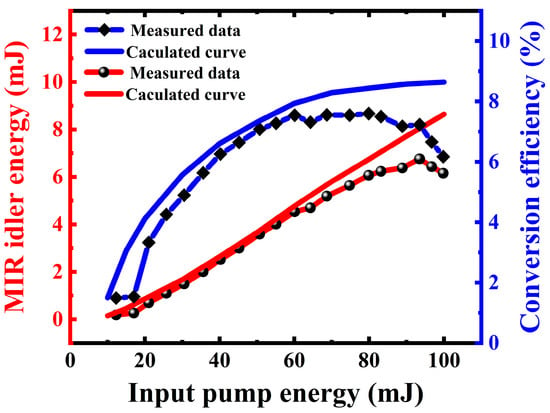
Figure 3.
Measured and simulated MIR idler output pulse energy at 6.45 μm and o-o conversion efficiency versus input pump energy at 1064 nm.
Meanwhile, the simulated idler output energy (red solid line) and o-o conversion efficiency (blue solid line) as the functions of the input pump energy are also depicted in Figure 3. It can be seen that the measured data are in close agreement with the calculated results for the pump energy of less than 62 mJ. Afterward, the o-o conversion efficiency in theoretical simulations showed saturation phenomena such as the experimental measurement. However, with the pump energy further increasing to around 93 mJ, the calculated results were a little higher than the measured values. Moreover, no rollover behavior was exhibited in the theoretical simulation. The deviation could be mainly attributed to ignoring the thermal effect in the numerical model.
The pump and signal spectral intensity profiles recorded were monitored simultaneously by an optical spectrometer (Ocean Optics, NIR Quest 256, 800–2500 nm) at the maximum output energy. Both the pump and signal beams were collected in the same place by a coupling fiber. As shown in Figure 4, the measured spectrum consists of two parts with the central wavelength of 1064.3 nm and 1274.5 nm for the pump and the signal of the BGSe-OPO, respectively. Moreover, the energy conversion condition in the OPO process can be written by:
where the relation is λp < λs < λi. The measured pump wavelength λp was 1064 nm and the signal wavelength λs was 1274 nm. Thus, the corresponding idler wavelength λi was retrieved to be 6.45 μm.
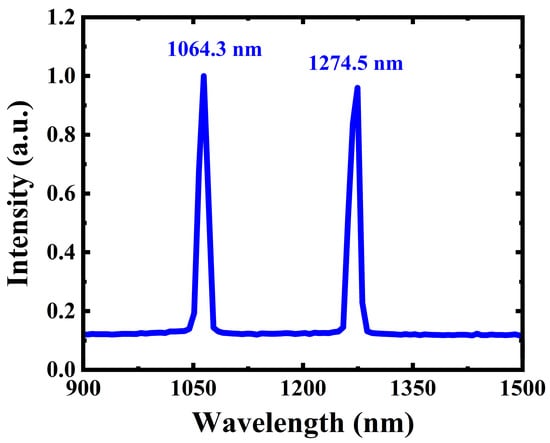
Figure 4.
Measured spectra of the pump and signal waves.
In addition, Figure 5 illustrates the temporal profiles of pump and idler pulses under the maximum output energy. They were measured by InGaAs (DET10A/M, THORLABS, rise time <1 ns, 200~1100 nm) and HgCdTe (PDAVJ10, THORLABS, 2.0~10.6 μm, bandwidth 100 MHz) detectors, respectively. Both collected temporal signals were recorded by a 2 GHz bandwidth digital oscilloscope (Tektronix, MSO 5204B, Beaverton, OR, USA). The measured pulse durations (FWHM) of the pump and the idler light are 24.47 ns and 18.85 ns, respectively. The idler pulse width is narrower than the pump pulse width resulting in the temporal gain narrowing effect in the OPO process [26]. Hence, the short pulse duration and high pulse energy bring about the MIR 6.45 μm laser having a high peak power of about 358.6 kW at the maximum output level.
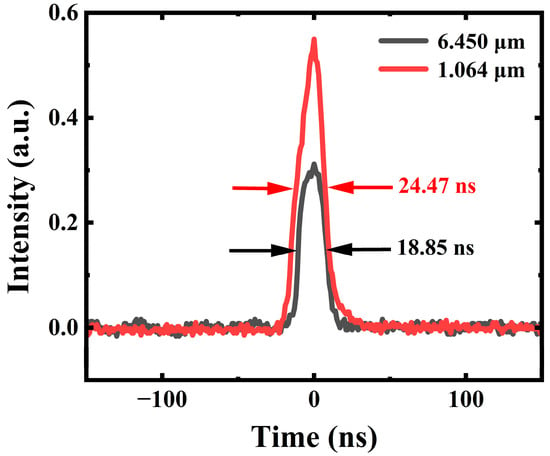
Figure 5.
The temporal pulse profiles of the pump wave and the MIR idler wave.
The measurement of beam quality factors M2 for the idler beam at 6.45 μm was carried out at the output energy of 4.5 mJ. The exit idler beam radii in the horizontal (x) and vertical (y) directions were measured at different distances from a CaF2 convex lens of f = 100 mm after OC mirror by a commercial MIR charge-coupled device (CCD) camera (Spiricon, PY-Ⅲ-HR-C-A). The plot in Figure 6 displays the measured beam caustic along the x (black squares) and y (red dots) transverse directions in terms of Gaussian approximation. By fitting the Gaussian beam standard expression, the beam quality values were calculated to be about 11.19 and 7.84 in x and y directions, respectively, corresponding to an average beam quality factor of M2 = 9.52. The insets of Figure 6 show the two-dimensional (2D) and three-dimensional (3D) spatial beam intensity profiles. It also indicated that the generated beam of the MIR wave has a good Gaussian spatial distribution, which is crucial for surgical applications.
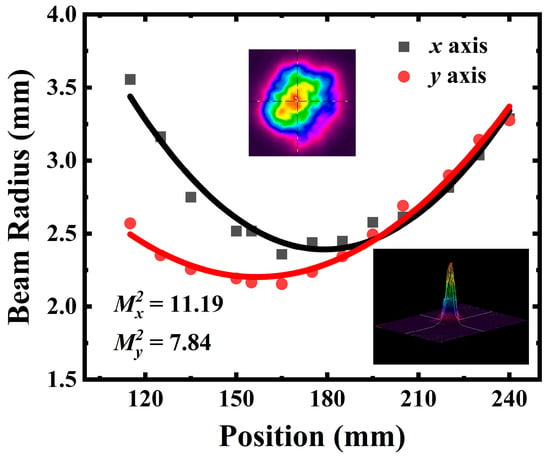
Figure 6.
Beam caustic measurement of generated MIR idler laser at 6.45 µm in x and y directions at an output pulse energy of 4.5 mJ. Insets: the measured 2D (top) and 3D (bottom) idler spatial beam intensity profiles.
It is worth mentioning that the stability of the idler output energy was also evaluated by an energy meter when the output energy was ~4.5 mJ. The measured results are shown in Figure 7, which demonstrates that the fluctuation of idler output energy was less than ±0.5% over 165 min. The excellent stability of the MIR light source is essential to the ablation of biological tissues. The stability of MIR laser output could be potentially further improved by controlling the stable output of the pump source.
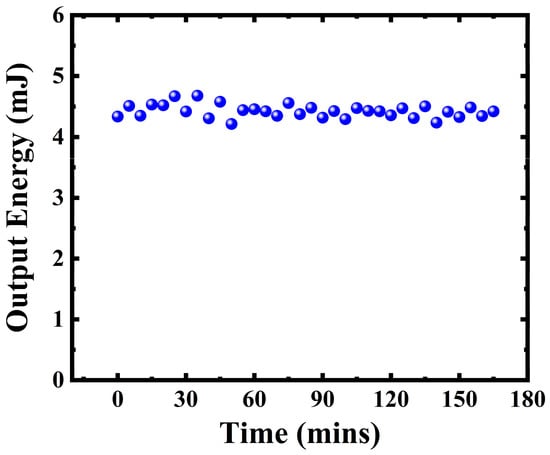
Figure 7.
Stability measurement at the idler output energy of 4.5 mJ over 165 min.
4. Conclusions
In summary, in this letter, we have demonstrated a stable, compact, efficient, high energy, all solid-state MIR pulsed 6.45 μm laser based on a ns extra-cavity BGSe-OPO configuration pumped by an electro-optically Q-switched Nd:YAG laser oscillator at 1064 nm. The DP-SRO configuration, longer NLO crystal with high quality and larger pump spots were employed to improve the output pulse energy. A maximum output pulse energy of 6.76 mJ was obtained at the PRR of 10 Hz when the input pump energy was 93.5 mJ, corresponding to an o-o conversion efficiency of 7.23% from 1064 nm to 6.45 μm. The experiment data are in reasonable agreement with the results of our theoretical simulation. To the best of our knowledge, these results represent both the highest pulse energy and highest o-o conversion efficiency at 6.45 μm for any 1 μm pumped OPOs to date. The pulse duration of a long MIR wave at 6.45 μm was measured to be 18.85 ns. Meanwhile, at idler output energy of 4.5 mJ, the beam quality factors M2 were measured to be 11.19 and 7.84 in the x and y directions, respectively, and the fluctuation of output energy was less than ±0.5% over 165 min. Such a simple, compact and rugged high energy coherent MIR laser at 6.45 μm is very relevant for numerous medical and biological applications, in particular for effective ablation of biological tissues as a laser scalpel. The results also indicate that BGSe crystal is a highly promising alternative for practical occasions of high energy, high power and high-efficiency long wave MIR laser radiation owing to its excellent characteristics, including, for example, wide transmission range, large nonlinear coefficients, 1 μm of laser pumping and a large size. It is expected that some much better performance MIR lasers can be obtained by increasing the damage threshold of AR coating at BGSe crystal end facts.
Author Contributions
Conceptualization, N.W. and Y.S.; methodology, N.W., Y.W. and Y.S.; software, N.W. and Y.F.; validation, Y.S., Y.W., E.W., J.Y., Y.F., H.G., Y.B., Z.C. and Q.P.; formal analysis, N.W., Y.W., Y.F. and Y.S.; investigation, N.W., Y.S., E.W. and Y.W.; resources, J.Y.; data curation, Y.S., N.W. and Z.C.; writing—original draft preparation, N.W. and Y.S.; writing—review and editing, Y.S. and Z.C.; visualization, Y.W., Y.S. and Z.C.; supervision, J.Y., H.G., Y.B., Z.C. and Q.P.; project administration, Y.S., Z.C. and J.Y.; funding acquisition, Y.S., Z.C. and J.Y. All authors have read and agreed to the published version of the manuscript.
Funding
This work is supported by the National Key Research and Development Program of China (Key special projects, Young Scientist, No. 2022YFB3607900), the Key Laboratory Foundation of Chinese Academy of Sciences, Key Lab of Solid-State Laser (No. CXJJ-22S020) and the National Special Support Program for High-level Talents in Science and Technology (Innovation Leading Talent Program Defense Technology Innovation Foundation, No. SQ2022RA24910010).
Institutional Review Board Statement
Not applicable.
Informed Consent Statement
Not applicable.
Data Availability Statement
The data presented in this study are available from the corresponding authors upon reasonable request.
Acknowledgments
We thank the Key Laboratory of Solid-State Laser and Key Laboratory of Functional Crystal and Laser Technology, the Technical Institute of Physics and Chemistry (TIPC), the Chinese Academy of Sciences (CAS). The authors also acknowledge the help (crystal test) from Chengdu Dien Photoelectric Technology Co., Ltd. (DIEN TECH) (Chengdu, China). We also sincerely thank the reviewers for their valuable comments and insightful suggestions.
Conflicts of Interest
The authors declare no conflict of interest.
References
- Tang, J.; Li, B.; Wang, J. High-precision measurements of nitrous oxide and methane in air with cavity ring-down spectroscopy at 7.6 µm. Atmos. Meas. Tech. 2019, 12, 2851–2861. [Google Scholar] [CrossRef]
- Haas, J.; Mizaikoff, B. Advances in mid-infrared spectroscopy for chemical analysis. Annu. Rev. Anal. Chem. 2016, 9, 45–68. [Google Scholar] [CrossRef] [PubMed]
- Ronald, W.W.; Ilko, K.I.; Israel, G. Mid-infrared laser applications in medicine and biology. Phil. Trans. R. Soc. Lond. A 2001, 359, 635–644. [Google Scholar]
- Edwards, G.S.; Pearlstein, R.D.; Copeland, M.L.; Hutson, M.S.; Latone, K.; Spiro, A.; Pasmanik, G. 6450 nm wavelength tissue ablation using a nanosecond laser based on difference frequency mixing and stimulated raman scattering. Opt. Lett. 2007, 32, 1426–1428. [Google Scholar] [CrossRef]
- Edwards, G.S.; Austin, R.H.; Carroll, F.E.; Copeland, M.L.; Couprie, M.E.; Gabella, W.E.; Haglund, R.F.; Hooper, B.A.; Hutson, M.S.; Jansen, E.D.; et al. Free-electron-laser-based biophysical and biomedical instrumentation. Rev. Sci. Instrum. 2003, 74, 3207–3245. [Google Scholar] [CrossRef]
- Edwards, G.; Logan, R.; Copeland, M.; Reinisch, L.; Davidson, J.; Johnson, B.; Maciunas, R.; Mendenhall, M.; Ossoff, R.; Tribble, J.; et al. Tissue ablation by a free-electron laser tuned to the amide II band. Nature 1994, 371, 416–419. [Google Scholar] [CrossRef]
- Kozub, J.; Ivanov, B.; Jayasinghe, A.; Prasad, R.; Shen, J.; Klosner, M.; Heller, D.; Mendenhall, M.; Piston, D.W.; Joos, K.; et al. Raman-shifted alexandrite laser for soft tissue ablation in the 6- to 7-µm wavelength range. Biomed. Opt. Express 2011, 2, 1275–1281. [Google Scholar] [CrossRef]
- Temelkov, K.A.; Vuchkov, N.K.; Freijo-Martin, I.; Lema, A.; Lyutov, L.; Sabotinov, N.V. Experimental study on the spectral and spatial characteristics of a high-power He–SrBr2 laser. J. Phys. D Appl. Phys. 2009, 42, 115105. [Google Scholar] [CrossRef]
- Xu, D.; Zhang, J.; He, Y.; Wang, Y.; Yao, J.; Guo, Y.; Yan, C.; Tang, L.; Li, J.; Zhong, K.; et al. High-energy, tunable, long-wave mid-infrared optical parametric oscillator based on BaGa4Se7 crystal. Opt. Lett. 2020, 45, 5287–5290. [Google Scholar] [CrossRef]
- Lv, Z.; Shen, Y.; Zong, N.; Bian, Q.; Wang, E.P.; Chang, J.Q.; Bo, Y.; Cui, D.F.; Peng, Q.J. 1.53 W all-solid-state nanosecond pulsed mid-infrared laser at 6.45 µm. Opt. Lett. 2022, 47, 1359–1362. [Google Scholar] [CrossRef]
- Boyko, A.A.; Marchev, G.M.; Petrov, V.; Pasiskevicius, V.; Kolker, D.B.; Zukauskas, A.; Kostyukova, N.Y. Intracavity-pumped, cascaded AgGaSe2 optical parametric oscillator tunable up to 18 µm. In Proceedings of the Mid-Infrared Coherent Sources, Long Beach, CA, USA, 20–22 March 2016. [Google Scholar]
- Yao, J.; Mei, D.; Bai, L.; Lin, Z.; Yin, W.; Fu, P.; Wu, Y. BaGa4Se7: A new congruent-melting IR nonlinear optical material. Inorg. Chem. 2010, 49, 9212–9216. [Google Scholar] [CrossRef] [PubMed]
- Schunemann, P.G.; Zawilski, K.T.; Pollak, T.M.; Zelmon, D.E.; Fernelius, N.C.; Hopkins, F.K. New nonlinear optical crystal for mid-IR OPOs: CdSiP2. In Proceedings of the Advanced Solid-State Photonics, Nara, Japan, 27–30 January 2008. [Google Scholar]
- Chaitanya Kumar, S.; Agnesi, A.; Dallocchio, P.; Pirzio, F.; Reali, G.; Zawilski, K.T.; Schunemann, P.G.; Ebrahim-Zadeh, M. Compact, 1.5 mJ, 450 MHz, CdSiP2 picosecond optical parametric oscillator near 6.3 μm. Opt. Lett. 2011, 36, 3236–3238. [Google Scholar] [CrossRef] [PubMed]
- Petrov, V.; Marchev, G.; Schunemann, P.G.; Tyazhev, A.; Zawilski, K.T.; Pollak., T.M. Sub-nanosecond, 1-kHz, temperature-tuned, non-critical mid-IR OPO based on CdSiP2 crystal pumped at 1064 nm. In Proceedings of the Conference on Lasers and Electro-Optics, San Jose, CA, USA, 16–21 May 2010. [Google Scholar]
- Zhao, X.; Li, C.; Bai, J.; Wang, Z.; Yao, J.; Tan, R.; Xu, X. Recalibration of the nonlinear optical coefficients of BaGa4Se7 crystal using second-harmonic-generation method. Opt. Lett. 2021, 46, 5894–5897. [Google Scholar] [CrossRef]
- Yelisseyev, A.P.; Lobanov, S.I.; Krinitsin, P.G.; Isaenko, L.I. The optical properties of the nonlinear crystal BaGa4Se7. Opt. Mater. 2020, 99, 109564. [Google Scholar] [CrossRef]
- Kostyukova, N.Y.; Boyko, A.A.; Badikov, V.; Badikov, D.; Shevyrdyaeva, G.; Panyutin, V.; Marchev, G.M.; Kolker, D.B.; Petrov, V. Widely tunable in the mid-IR BaGa4Se7 optical parametric oscillator pumped at 1064 nm. Opt. Lett. 2016, 41, 3667–3670. [Google Scholar] [CrossRef]
- Shen, Y.; Wen, N.; Li, C.; Zong, N.; Yao, J.; Chang, J.; Wen, Y.; Yang, F.; Li, W.; Gao, H.; et al. High pulse energy, narrow linewidth 6.45 μm from an optical parametric oscillator in BaGa4Se7 crystal. Appl. Sci. 2022, 12, 6689. [Google Scholar] [CrossRef]
- He, Y.; Yan, C.; Chen, K.; Xu, D.; Li, J.; Zhong, K.; Wang, Y.; Yao, R.; Yao, J.; Yao, J. High repetition rate, tunable mid-infrared BaGa4Se7 optical parametric oscillator pumped by a 1 μm Nd:YAG laser. Appl. Sci. 2022, 12, 7197. [Google Scholar] [CrossRef]
- Kato, K.; Miyata, K.; Petrov, V. Phase-matching properties of BaGa4Se7 for SHG and SFG in the 0.901–10.5910 μm range. Appl. Opt. 2017, 56, 2978–2981. [Google Scholar] [CrossRef]
- Li, C.; Li, Z.; Sun, M.; Huang, C.; Yao, J. High-pressure synthesis, growth and characterization of large-size BaGa4Se7 crystals. J. Cryst. Growth 2022, 577, 126405. [Google Scholar] [CrossRef]
- Brosnan, S.J.; Byer, R.L. Optical parametric oscillator threshold and linewidth studies. IEEE J. Quantum. Elect. 1979, 15, 415–431. [Google Scholar] [CrossRef]
- Smith, A.V.; Alford, W.J.; Raymond, T.D.; Bowers, M.S. Comparison of a numerical model with measured performance of a seeded, nanosecond KTP optical parametric oscillator. J. Opt. Soc. Am. B 1995, 12, 2253–2267. [Google Scholar] [CrossRef]
- SNLO Nonlinear Optics Code Available from A.V. Smith, AS-Photonics, Albuquerque, NM. Available online: http://as-photonics.com/SNLO/ (accessed on 10 May 2023).
- Boyd, R.W. Nonlinear Optics; Academic Press: New York, NY, USA, 2003. [Google Scholar]
Disclaimer/Publisher’s Note: The statements, opinions and data contained in all publications are solely those of the individual author(s) and contributor(s) and not of MDPI and/or the editor(s). MDPI and/or the editor(s) disclaim responsibility for any injury to people or property resulting from any ideas, methods, instructions or products referred to in the content. |
© 2023 by the authors. Licensee MDPI, Basel, Switzerland. This article is an open access article distributed under the terms and conditions of the Creative Commons Attribution (CC BY) license (https://creativecommons.org/licenses/by/4.0/).